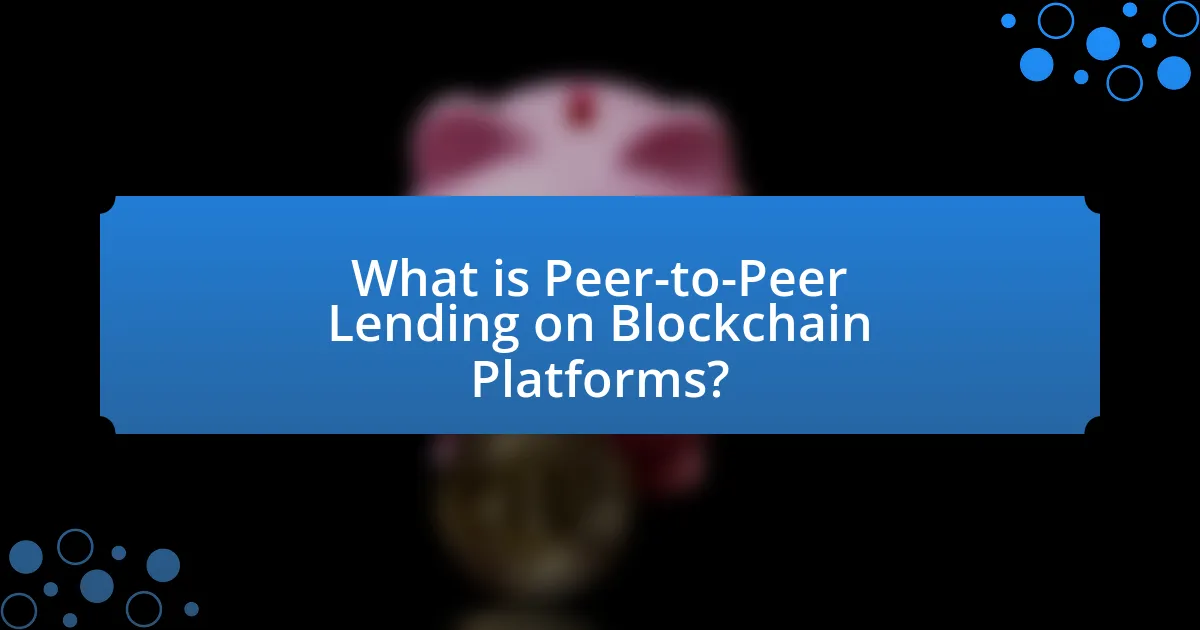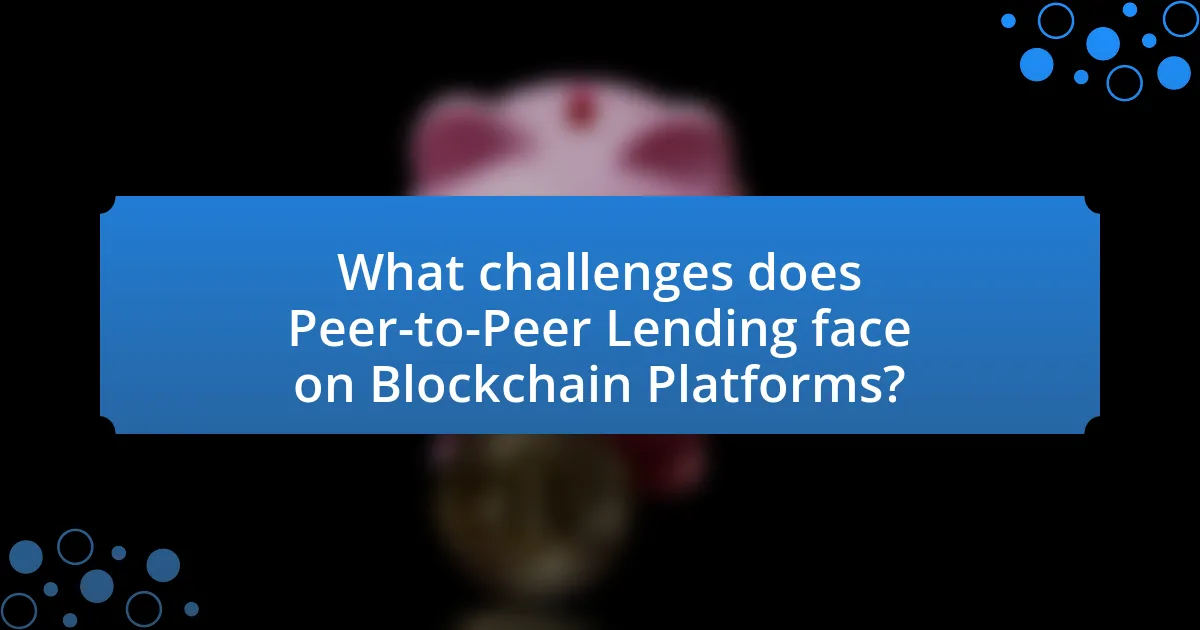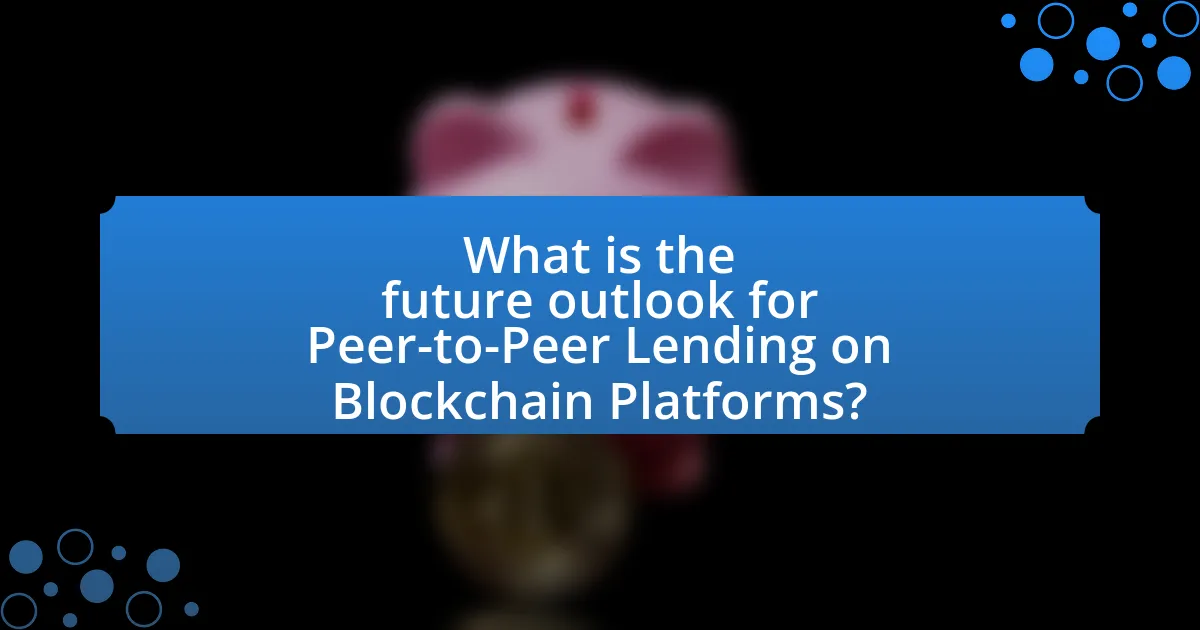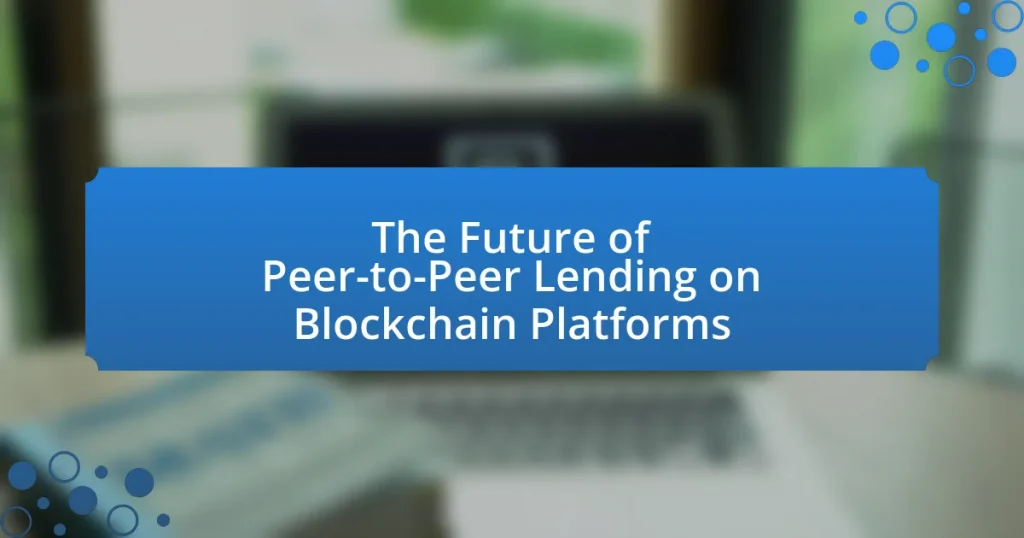Peer-to-Peer (P2P) lending on blockchain platforms represents a decentralized financial system that enables direct transactions between borrowers and lenders, eliminating the need for intermediaries. This article explores the functioning of P2P lending within blockchain ecosystems, highlighting key components such as decentralization, smart contracts, and transparency that enhance security and reduce costs. It also addresses the advantages of blockchain technology in lending, the challenges faced, including regulatory issues and scalability, and the future outlook for this innovative financial model. Additionally, the article examines how advancements in technology, including artificial intelligence and decentralized finance (DeFi), are shaping the landscape of P2P lending, along with emerging market trends and best practices for users.

What is Peer-to-Peer Lending on Blockchain Platforms?
Peer-to-Peer (P2P) lending on blockchain platforms is a decentralized financial system that allows individuals to lend and borrow money directly from each other without intermediaries like banks. This model leverages blockchain technology to facilitate secure, transparent transactions and smart contracts, which automate the lending process and ensure compliance with agreed terms. According to a report by the Cambridge Centre for Alternative Finance, P2P lending has grown significantly, with blockchain integration enhancing trust and reducing costs associated with traditional lending methods.
How does Peer-to-Peer Lending function within Blockchain ecosystems?
Peer-to-Peer (P2P) lending within Blockchain ecosystems functions by enabling direct transactions between borrowers and lenders without intermediaries, utilizing smart contracts to automate and secure the lending process. In this model, borrowers submit loan requests on a decentralized platform, while lenders can review these requests and choose to fund them based on their criteria. Smart contracts facilitate the terms of the loan, including interest rates and repayment schedules, ensuring that funds are released only when conditions are met. This system enhances transparency and reduces costs associated with traditional lending, as evidenced by platforms like Aave and Compound, which leverage blockchain technology to streamline operations and provide real-time data on loan performance.
What are the key components of Blockchain technology that facilitate Peer-to-Peer Lending?
The key components of Blockchain technology that facilitate Peer-to-Peer Lending include decentralization, smart contracts, transparency, and security. Decentralization allows for direct transactions between lenders and borrowers without intermediaries, reducing costs and increasing efficiency. Smart contracts automate the lending process by executing terms and conditions once predefined criteria are met, ensuring trust and reducing the risk of default. Transparency is achieved through a public ledger that records all transactions, allowing participants to verify the legitimacy of loans and borrower creditworthiness. Lastly, security is enhanced through cryptographic techniques that protect user data and transaction integrity, making the platform more resilient to fraud. These components collectively create a more efficient, trustworthy, and secure environment for Peer-to-Peer Lending.
How do smart contracts enhance the Peer-to-Peer Lending process?
Smart contracts enhance the Peer-to-Peer Lending process by automating transactions and enforcing agreements without intermediaries. This automation reduces the time and costs associated with traditional lending, as smart contracts execute terms automatically when conditions are met, such as the transfer of funds upon loan approval. Additionally, they increase transparency and security, as all transactions are recorded on a blockchain, making them immutable and easily auditable. According to a report by the World Economic Forum, blockchain technology, including smart contracts, can potentially reduce operational costs in financial services by up to 30%.
What are the advantages of using Blockchain for Peer-to-Peer Lending?
The advantages of using Blockchain for Peer-to-Peer Lending include enhanced security, increased transparency, reduced costs, and faster transactions. Blockchain technology employs cryptographic techniques that secure transactions, making it difficult for unauthorized parties to alter data. This security fosters trust among users. Additionally, the decentralized nature of Blockchain eliminates intermediaries, which reduces transaction fees and processing times. According to a report by Deloitte, Blockchain can lower transaction costs by up to 40% in financial services. Furthermore, the transparent ledger allows all participants to view transaction histories, promoting accountability and reducing the risk of fraud.
How does Blockchain improve transparency in lending transactions?
Blockchain improves transparency in lending transactions by providing an immutable and publicly accessible ledger of all transaction activities. This technology allows all parties involved in a lending transaction to view the same data in real-time, reducing the risk of fraud and misinformation. Each transaction is recorded with a unique cryptographic hash, ensuring that once data is entered, it cannot be altered or deleted. For instance, a study by the World Economic Forum highlighted that blockchain can reduce operational costs and increase trust among participants by enabling transparent tracking of loan agreements and repayments. This level of transparency fosters accountability and enhances the overall integrity of the lending process.
What cost savings can borrowers and lenders expect from Blockchain-based platforms?
Borrowers and lenders can expect significant cost savings from blockchain-based platforms due to reduced transaction fees and streamlined processes. Blockchain technology eliminates intermediaries, such as banks and payment processors, which traditionally charge fees for their services. For instance, transaction costs on blockchain platforms can be as low as 1% compared to traditional lending fees that can exceed 5%. Additionally, the automation of smart contracts reduces administrative costs and processing times, leading to further savings. A study by Deloitte found that blockchain could save the financial services industry up to $20 billion annually by increasing efficiency and reducing operational costs.

What challenges does Peer-to-Peer Lending face on Blockchain Platforms?
Peer-to-Peer lending on blockchain platforms faces several challenges, including regulatory uncertainty, scalability issues, and security concerns. Regulatory uncertainty arises because many jurisdictions have not yet established clear guidelines for blockchain-based lending, which can hinder adoption and create legal risks for participants. Scalability issues are significant as blockchain networks may struggle to handle a high volume of transactions efficiently, potentially leading to delays and increased costs. Security concerns also persist, as smart contracts and decentralized applications can be vulnerable to hacks and exploits, jeopardizing user funds and trust in the platform. These challenges must be addressed for Peer-to-Peer lending on blockchain to reach its full potential.
How do regulatory issues impact the growth of Peer-to-Peer Lending on Blockchain?
Regulatory issues significantly hinder the growth of Peer-to-Peer Lending on Blockchain by creating uncertainty and compliance challenges for platforms. These platforms must navigate complex legal frameworks that vary by jurisdiction, which can lead to increased operational costs and limit their ability to scale. For instance, in the United States, the Securities and Exchange Commission (SEC) has classified certain tokens as securities, requiring platforms to adhere to stringent regulations that can stifle innovation and market entry. Additionally, regulatory scrutiny can deter potential investors and borrowers, as concerns about the legitimacy and security of blockchain-based lending arise. This regulatory landscape ultimately restricts the expansion and adoption of Peer-to-Peer Lending on Blockchain, as platforms may choose to limit their services or exit markets with overly burdensome regulations.
What are the current regulations affecting Blockchain lending platforms?
Current regulations affecting blockchain lending platforms primarily include securities laws, anti-money laundering (AML) requirements, and consumer protection regulations. In the United States, the Securities and Exchange Commission (SEC) classifies certain tokens and offerings as securities, which mandates compliance with registration and disclosure requirements. Additionally, the Financial Crimes Enforcement Network (FinCEN) enforces AML regulations that require platforms to implement Know Your Customer (KYC) processes to prevent illicit activities. Furthermore, various states have introduced their own regulations, such as New York’s BitLicense, which imposes strict operational and compliance standards on cryptocurrency businesses. These regulations aim to ensure transparency, protect consumers, and mitigate risks associated with blockchain lending activities.
How can platforms navigate compliance challenges?
Platforms can navigate compliance challenges by implementing robust regulatory frameworks and leveraging technology for real-time monitoring. By establishing clear compliance protocols that align with local and international regulations, platforms can ensure adherence to legal standards. For instance, utilizing blockchain technology allows for transparent transaction records, which can simplify audits and regulatory reporting. Additionally, platforms can engage legal experts to interpret complex regulations and adapt their operations accordingly, thereby minimizing risks associated with non-compliance. This approach is supported by the increasing trend of regulatory bodies recognizing the importance of technology in enhancing compliance efforts, as seen in various jurisdictions adopting guidelines for blockchain-based financial services.
What technological hurdles must be overcome for Peer-to-Peer Lending on Blockchain?
Peer-to-Peer lending on blockchain faces several technological hurdles, including scalability, regulatory compliance, and security. Scalability issues arise from the limited transaction throughput of many blockchain networks, which can hinder the ability to process a high volume of loans efficiently. Regulatory compliance is challenging due to the varying legal frameworks across jurisdictions, necessitating adaptable solutions that can meet diverse regulatory requirements. Security concerns, particularly regarding smart contracts and user data protection, must also be addressed to prevent fraud and ensure trust in the lending platform. These hurdles must be overcome to enable the widespread adoption of blockchain-based peer-to-peer lending systems.
What scalability issues do Blockchain platforms face in lending?
Blockchain platforms face significant scalability issues in lending primarily due to limited transaction throughput and high latency. For instance, Bitcoin processes approximately 7 transactions per second, while Ethereum handles around 30, which is insufficient for high-volume lending applications that require rapid transaction confirmations. Additionally, as the number of users increases, the network can become congested, leading to slower transaction times and higher fees, which can deter users from utilizing the platform. These limitations hinder the ability of blockchain platforms to support large-scale lending operations effectively.
How does user adoption affect the success of Peer-to-Peer Lending on Blockchain?
User adoption significantly influences the success of Peer-to-Peer Lending on Blockchain by driving liquidity and trust within the platform. High user adoption leads to a larger pool of lenders and borrowers, which enhances the platform’s ability to match supply with demand effectively. For instance, a study by the Cambridge Centre for Alternative Finance found that platforms with higher user engagement experienced a 30% increase in transaction volume, indicating that more users directly correlate with increased lending activity. Furthermore, user adoption fosters a community of trust, as positive experiences shared among users can attract new participants, thereby creating a self-reinforcing cycle that boosts platform credibility and growth.

What is the future outlook for Peer-to-Peer Lending on Blockchain Platforms?
The future outlook for Peer-to-Peer (P2P) lending on blockchain platforms is promising, driven by increased transparency, reduced costs, and enhanced security. Blockchain technology enables decentralized lending, allowing borrowers and lenders to interact directly without intermediaries, which can lower transaction fees and improve efficiency. According to a report by Allied Market Research, the global P2P lending market is projected to reach $897 billion by 2024, indicating significant growth potential. Additionally, the integration of smart contracts can automate loan agreements, further streamlining the lending process and reducing the risk of default. As regulatory frameworks evolve to accommodate blockchain innovations, the adoption of P2P lending on these platforms is expected to expand, attracting more users and investment.
How might advancements in technology shape Peer-to-Peer Lending?
Advancements in technology will significantly enhance Peer-to-Peer (P2P) lending by increasing efficiency, transparency, and accessibility. For instance, blockchain technology can streamline the lending process by enabling smart contracts that automate loan agreements, reducing the need for intermediaries and lowering transaction costs. According to a report by Deloitte, blockchain can improve the security and traceability of transactions, which builds trust among users. Additionally, machine learning algorithms can analyze borrower data more effectively, allowing for better risk assessment and personalized lending options. This technological evolution is expected to attract more participants to P2P lending platforms, ultimately expanding the market and fostering financial inclusion.
What role will artificial intelligence play in enhancing lending decisions?
Artificial intelligence will significantly enhance lending decisions by improving risk assessment and personalizing loan offerings. AI algorithms analyze vast amounts of data, including credit history, transaction patterns, and social behavior, to predict borrower creditworthiness more accurately than traditional methods. For instance, a study by McKinsey & Company found that AI can reduce loan default rates by up to 30% by identifying high-risk borrowers through advanced predictive analytics. This capability allows lenders to make more informed decisions, streamline the approval process, and tailor financial products to meet individual borrower needs effectively.
How could the integration of decentralized finance (DeFi) impact Peer-to-Peer Lending?
The integration of decentralized finance (DeFi) could significantly enhance Peer-to-Peer Lending by increasing accessibility and reducing costs. DeFi platforms utilize smart contracts on blockchain technology, which automate lending processes, eliminate intermediaries, and lower transaction fees. For instance, a report by the World Economic Forum indicates that DeFi can streamline lending operations, making it possible for borrowers and lenders to connect directly without traditional financial institutions, thereby increasing efficiency. Additionally, the transparency and security of blockchain can build trust among users, potentially leading to a higher volume of transactions in Peer-to-Peer Lending.
What trends should investors watch in the Peer-to-Peer Lending space?
Investors should watch the increasing integration of blockchain technology in the Peer-to-Peer (P2P) lending space. This trend is driven by blockchain’s ability to enhance transparency, reduce transaction costs, and improve security in lending processes. For instance, platforms utilizing blockchain can offer smart contracts that automate loan agreements, thereby minimizing the need for intermediaries and expediting transactions. According to a report by Allied Market Research, the global blockchain in the financial services market is expected to reach $22.5 billion by 2026, indicating a significant shift towards blockchain adoption in various financial sectors, including P2P lending. Additionally, the rise of decentralized finance (DeFi) is reshaping traditional lending models, allowing for more accessible and inclusive lending options.
Which emerging markets are likely to adopt Blockchain-based lending solutions?
Emerging markets such as India, Brazil, and Nigeria are likely to adopt Blockchain-based lending solutions. These countries have a high percentage of unbanked populations, with India having approximately 190 million unbanked adults, Brazil facing significant credit access challenges, and Nigeria’s financial inclusion rate at around 63%. Blockchain technology can provide secure, transparent, and efficient lending processes, addressing the barriers these markets face in traditional banking systems. The increasing smartphone penetration and internet access in these regions further facilitate the adoption of such innovative financial solutions.
How are consumer preferences shifting towards digital lending platforms?
Consumer preferences are shifting towards digital lending platforms due to their convenience, speed, and accessibility. Research indicates that 70% of consumers prefer online applications for loans over traditional methods, as digital platforms offer quicker approval times and a streamlined user experience. Additionally, the rise of mobile technology has enabled borrowers to access loans anytime and anywhere, further driving this trend. The increasing trust in fintech solutions, supported by a growing number of positive user experiences, reinforces this shift towards digital lending.
What best practices should users follow when engaging with Peer-to-Peer Lending on Blockchain?
Users engaging with Peer-to-Peer Lending on Blockchain should prioritize thorough research and due diligence before participating in any lending platform. This involves evaluating the platform’s reputation, understanding the underlying technology, and reviewing user feedback to assess reliability and security. Additionally, users should diversify their investments across multiple loans to mitigate risk, as concentrating funds in a single loan increases exposure to potential defaults.
Furthermore, users must be aware of the regulatory landscape surrounding blockchain lending, as compliance with local laws can impact the legitimacy and safety of their investments. It is also advisable to utilize platforms that offer transparent information regarding interest rates, fees, and borrower profiles, ensuring informed decision-making. Lastly, maintaining a secure digital wallet and employing strong security practices, such as two-factor authentication, is crucial to protect assets from potential cyber threats.


